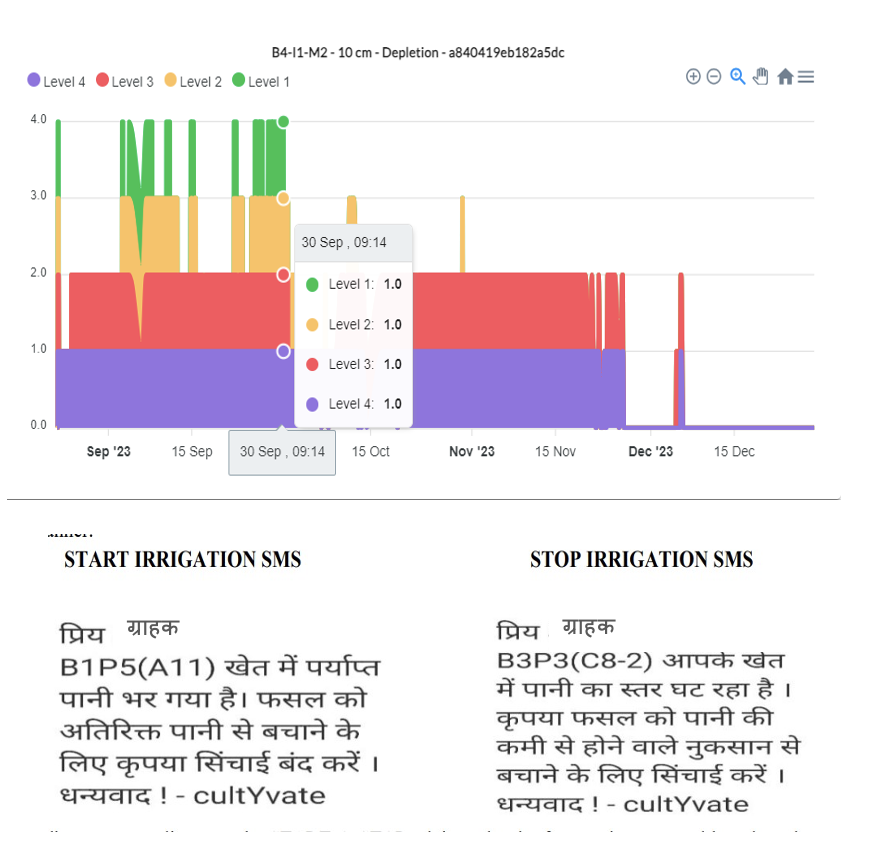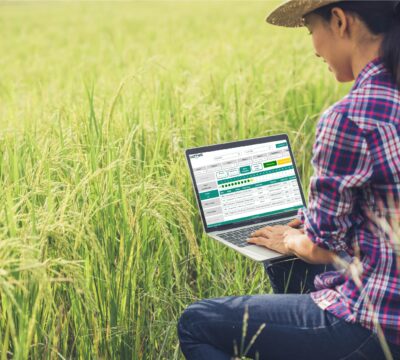
Paddy cultivation is essential to growing rice, a crucial staple for a significant portion of the world’s population. This intricate cultivation method encompasses a range of agricultural practices, commencing with field preparation and culminating in the harvest. In the present global landscape, paramount concerns revolve around water conservation, climate change, and other environmental impacts. This blog delves into the transformative role of Alternate Wetting and Drying (AWD) techniques coupled with innovative soil moisture sensors, showcasing their superiority over the conventional approach to rice cultivation—continuous flooding. The traditional method of continuous flooding is like the excess baggage we don’t need.
In the expansive and scenic rice paddy landscapes, continuous flooding is a time-honoured practice that stands as a steadfast, watery companion to our cherished rice plants. Continuous flooding serves as a traditional water management method in rice cultivation. Under this approach, paddy fields remain consistently submerged in water throughout the growing season. The water level is meticulously maintained at a specific depth, usually spanning from a few centimetres to several inches, enveloping the soil surface and cradling the base of the rice plants.
Understanding Alternate Wetting and Drying (AWD):
Alternate Wetting and Drying (AWD) is a water management technique used in paddy (rice) cultivation. Traditionally, paddy fields are flooded continuously, maintaining a constant water level throughout the growing season. However, with AWD, farmers intentionally allow the soil to dry periodically between irrigations.
In AWD, the water level in the paddy field is alternately raised and lowered. The cycle involves periods of flooding (wetting) followed by periods where the field is allowed to dry. This approach can help optimize water use and reduce water consumption in rice cultivation, which is particularly important in regions facing water scarcity or where water resources need to be managed efficiently.
The benefits of Alternate Wetting and Drying include:
- Water Conservation: AWD helps in conserving water by allowing the soil to dry periodically, reducing overall water consumption compared to continuous flooding.
- Energy Savings: Since water is not continuously pumped into the fields, there is energy savings associated with AWD, as less energy is required for irrigation.
- Reduced Methane Emissions: Continuous flooding in traditional rice cultivation can lead to the production of methane, a potent greenhouse gas. Allowing the field to dry periodically can reduce methane emissions.
- Improved Soil Health: Alternating wet and dry conditions can promote better aeration of the soil, potentially improving soil structure and nutrient availability.
- Cost Savings: AWD can result in cost savings for farmers, as it reduces the amount of water and energy required for irrigation.
AWD in Rice Farming: Challenges and Opportunities
While Alternative Wetting and Drying (AWD) holds significant promise for water conservation and environmental sustainability in rice farming, its path to widespread adoption has not been without obstacles. Here, we delve into the key challenges that have hindered AWD’s success in the past and explore potential solutions to pave the way for a brighter future.
- One of the major hurdles faced by AWD is the lack of awareness and training among farmers. Many remain hesitant to adopt this new technology due to concerns about potential yield losses. This necessitates comprehensive awareness campaigns and adequate training programs to educate farmers about the benefits of AWD and equip them with the necessary skills for its proper implementation.
- Poor water management can also lead to the failure of AWD. Precise monitoring of soil moisture and careful regulation of water application are crucial for optimal results. Insufficient infrastructure and inaccurate measurement tools can easily derail the process, resulting in water stress or overwatering, both detrimental to rice production.
- AWD can also exacerbate weed and pest issues. Dry periods during the cycle can create ideal conditions for weed growth, necessitating additional control measures. Additionally, changes in soil moisture can impact pest populations, requiring farmers to adjust their control strategies accordingly.
- Socio-economic factors also play a significant role in the adoption of AWD. Land tenure issues, lack of access to financial resources, and market uncertainties can discourage farmers from taking the leap. Moreover, deeply ingrained cultural preferences and traditional farming practices can be difficult to overcome.
- Environmental factors like soil type, climate, and topography can also impact the effectiveness of AWD. Failure to consider these local conditions during implementation can lead to negative outcomes. Long-term monitoring and research are crucial to assess the effectiveness of AWD in different contexts and provide valuable data for further improvement.
- Inadequate infrastructure and technical support can hinder the implementation of AWD. Farmers often lack access to the necessary tools and resources, such as moisture sensors and reliable irrigation systems, making it difficult to implement AWD effectively. Additionally, the absence of readily available technical support can leave farmers feeling overwhelmed and discouraged.
- Setting unrealistic expectations about AWD can also lead to disappointment and hinder its adoption. AWD is not a magic bullet, and yield increases may not be significant in all situations. Farmers need to be aware of the potential benefits and limitations of AWD to set realistic expectations and avoid discouragement.
- Governments have a crucial role to play in promoting the adoption of AWD through supportive policies and incentives. Lack of such support can hinder the widespread implementation of this sustainable practice.
Finally, regular monitoring and evaluation are essential for identifying and addressing challenges, adapting strategies for improvement, and maximizing the effectiveness of AWD. Insufficient monitoring can hinder progress and limit the learning process, ultimately hindering the potential of this technology.
By addressing these challenges and focusing on farmer education, research, infrastructure development, supportive policies, and rigorous monitoring and evaluation, AWD can overcome its past shortcomings and achieve its full potential as a sustainable water management solution for rice cultivation. This will require a collaborative effort from farmers, researchers, policymakers, and other stakeholders to ensure a water-secure future for rice farming.
Our cultYvate’s soil moisture sensors have the potential to play a pivotal role in revolutionizing the practice of Alternate Wetting and Drying (AWD) in rice farming. Here’s how:
- Precise Water Management: AWD success hinges on accurate monitoring of soil moisture levels. Our sensors can provide real-time data on moisture content, enabling farmers to precisely time their irrigation applications and optimize water usage. This eliminates guesswork and minimizes the risk of water stress and overwatering, leading to improved yield potential.
- Enhanced Efficiency: Traditional AWD practices often rely on manual monitoring or visual cues, which can be inaccurate and time-consuming. Our sensors automate the process, freeing up farmers’ time and resources for other tasks. Additionally, data analysis can reveal trends and patterns, allowing for more efficient irrigation scheduling and resource allocation.
- Reduced Labor Costs: Eliminating the need for manual soil moisture checks significantly reduces labor costs associated with AWD implementation. This makes the practice more attractive to farmers, especially those with limited resources.
- Improved Crop Health: By ensuring optimal soil moisture conditions, our sensors can contribute to healthier and more robust rice crops. Consistent moisture levels minimize stress, promote root development, and reduce the risk of diseases and pests, ultimately leading to better yields and improved quality.
- Scalability and Sustainability: Our sensors can be easily deployed across different farm sizes and terrains, making them adaptable to various rice-growing environments. This scalability allows for wider adoption of AWD, promoting sustainable farming practices and reducing overall water usage in the agricultural sector.
- Data-Driven Decision Making: The data collected by our sensors can provide valuable insights into soil properties, water use patterns, and crop response. Farmers can leverage this data to make informed decisions about irrigation scheduling, fertilizer application, and other agricultural practices, leading to increased productivity and resource optimization.
- . Integration with Existing Systems: Our sensors can be easily integrated with existing irrigation systems, allowing for automated control of water application based on real-time moisture data. This seamless integration eliminates the need for additional infrastructure or complex changes to traditional farming practices.
- Cost-Effectiveness: By reducing water usage, labor costs, and the risk of crop failure, our sensors offer substantial economic benefits to farmers. Additionally, the low cost of deployment and maintenance makes them a financially viable solution for rice farmers of all scales.
- Automated Irrigation Control: Our soil moisture sensors, in addition to sensing water levels, facilitate automated messages or calls to initiate and cease irrigation. In the event that a farmer does not take action following our automated communication, the system is designed to escalate the matter to the field officer responsible for that specific area. This ensures a prompt and personalized response, enhancing the effectiveness of our irrigation management system.
Here’s what our delighted farmers have to say:
“This is truly an amazing product as due to these sensors I am weekly irrigating two times lesser now”- Sardar Balwant Singh.
“Because of the advisory, even when I am outside, I use to get updated to turn off the pump and turn on the pump”- Gurbaxpura Farmers
As the leading producer of rice, Punjab faces the imminent risk of desertification due to excessive water usage in traditional rice cultivation methods. Cultyvate, in collaboration with CIPT (Centre for International Projects Trust), addresses Punjab’s critical agricultural challenges. Cultyvate’s AWD IoT sensor & cloud farm advisory solution intervenes by sending real-time notifications to farmers about soil moisture levels, enabling precise irrigation management. By employing this system, farmers efficiently alternate between field drying and flooding, conserving up to 50% of water usage. This reduced irrigation not only saves on fuel and electricity but also fosters healthier crops, minimizing stress and reducing the need for pesticides. Additionally, the precision in irrigation significantly cuts Methane (GHG) emissions by up to 60%, allowing farmers to earn carbon credits, thus transforming paddy cultivation in Punjab towards sustainable, eco-friendly practices
Future outlook:
The potential for the widespread adoption of Alternate Wetting and Drying (AWD) holds promising prospects for the future of rice cultivation. AWD is an innovative irrigation technique that involves periodically allowing rice fields to dry out rather than maintaining continuous flooding. This method not only conserves water but also offers several potential benefits:
Water Conservation: AWD has the potential to significantly reduce water usage in rice cultivation. By intermittently drying the fields, farmers can achieve substantial water savings compared to traditional continuous flooding methods. AWD has been noted as an economical approach with the potential to decrease water consumption by 25–30% (Kürschner et al., 2010; Kulkarni, 2011; Rahman and Bulbul, 2015).
Increased Water Use Efficiency: AWD promotes more efficient water use by rice plants. By allowing periods of dryness, the technique encourages the development of aeration in the soil, enhancing nutrient uptake and overall plant health.
Environmental Sustainability: The reduction in water usage associated with AWD contributes to environmental sustainability. It helps mitigate the environmental impact of rice cultivation, such as decreased methane emissions and a lower carbon footprint. Chirinda et al. (2017) indicated that AWD mitigates environmental risks by decreasing methane emissions.
Adaptability to Climate Change: AWD offers adaptability to changing climate conditions. With unpredictable water availability due to climate change, the flexibility of AWD provides resilience to variations in precipitation and water supply.
Cost Savings for Farmers: As AWD can lead to reduced water and energy consumption, farmers may experience cost savings. The method also offers the potential for increased crop yields, further contributing to economic benefits. AWD has the potential to lower irrigation costs by 15% (Alam et al., 2009) and reduce the utilization of irrigation resources by as much as 38% (Lampayan et al., 2015).
Improved Crop Performance: AWD has shown positive effects on rice yield and quality. The controlled periods of drying contribute to better root development and nutrient utilization, leading to improved overall crop performance.
Global Applicability: AWD is not limited to specific regions and can be adapted to various agro-climatic conditions. Its potential for widespread adoption makes it a versatile and scalable solution for rice cultivation globally.
Conclusion:
In conclusion, the exploration of Alternate Wetting and Drying (AWD) techniques coupled with innovative soil moisture sensors reveals a transformative potential for revolutionizing rice cultivation. Despite the traditional method of continuous flooding, AWD offers a sustainable approach that addresses critical challenges in water conservation, energy efficiency, and environmental impact. While challenges such as farmer awareness, water management, and socio-economic factors hinder widespread adoption, the success stories from case studies in Vietnam and India showcase the promise of IoT-enabled AWD in reducing water consumption, cutting energy costs, and enhancing rice yields. The future outlook for AWD is optimistic, as it demonstrates adaptability to climate change, cost savings for farmers, improved crop performance, and global applicability, highlighting its role as a key solution for a sustainable and water-secure future in rice farming. Continued collaboration, education, and technological advancements will be pivotal in unlocking the full potential of AWD and ensuring its positive impact on agriculture and the environment.
References
Alam, M.S., Islam, M.S., Salam, M.A. and Islam, M.A., 2009. Economics of alternate wetting and drying method of irrigation: evidences from farm level study. The Agriculturists, pp.82-89.
Chirinda, N., Arenas, L., Loaiza, S., Trujillo, C., Katto, M., Chaparro, P., Nuñez, J., Arango, J., Martinez-Baron, D., Loboguerrero, A.M. and Becerra Lopez-Lavalle, L.A., 2017. Novel technological and management options for accelerating transformational changes in rice and livestock systems. Sustainability, 9(11), p.1891.
Kulkarni, J.N., 2011. Perioperative morbidity of radical cystectomy: A review. Indian Journal of Urology: IJU: Journal of the Urological Society of India, 27(2), p.226.
Kürschner, E., Henschel, C., Hildebrandt, T., Jülich, E., Leineweber, M. and Paul, C., 2010. Water saving in rice production–dissemination, adoption and short term impacts of alternate wetting and drying (AWD) in Bangladesh. Humboldt-Universitat Zu Berlin SLE Publication Series, p.S241.
Lampayan, R.M., Rejesus, R.M., Singleton, G.R. and Bouman, B.A., 2015. Adoption and economics of alternate wetting and drying water management for irrigated lowland rice. Field Crops Research, 170, pp.95-108.
Rahman, M.R. and Bulbul, S.H., 2015. Adoption of water saving irrigation techniques for sustainable rice production in Bangladesh. Environment and Ecology Research, 3(1), pp.1-8.

